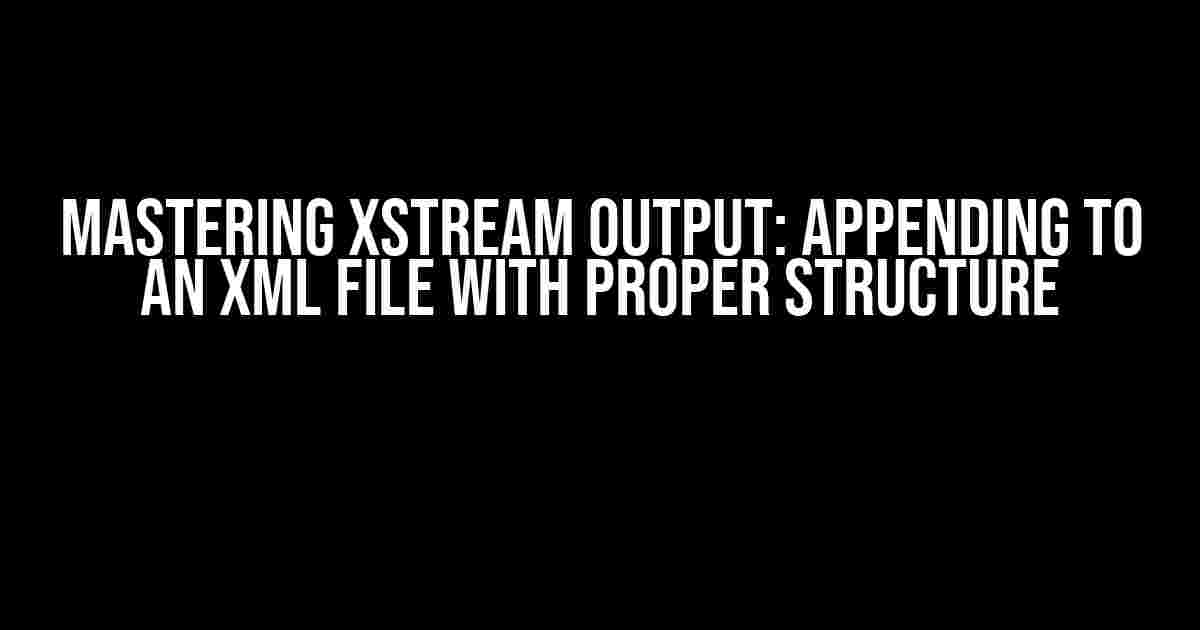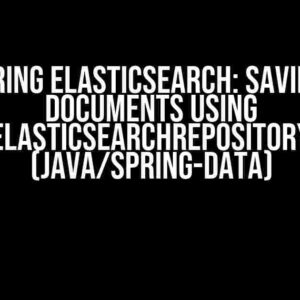As a developer, you’ve probably encountered the need to append xStream output to an existing XML file while maintaining its structure. This task can be daunting, especially if you’re new to xStream or XML. Fear not, dear reader, for this article will guide you through the process with crystal-clear instructions and examples. By the end of this journey, you’ll be an xStream master, capable of appending output to XML files with ease and precision.
Understanding xStream and XML Basics
Before diving into the nitty-gritty of appending xStream output, let’s quickly review the basics of xStream and XML.
xStream in a Nutshell
xStream is a popular open-source Java library used for serializing and deserializing objects to and from XML. It provides a simple, lightweight, and flexible way to work with XML data in your Java applications.
XML Fundamentals
XML (Extensible Markup Language) is a markup language used to store and transport data in a structured format. It consists of elements, attributes, and text content, which are used to describe and represent data.
| XML Component | Description |
|---|---|
| Elements | Represented by tags (<> and <), elements are the building blocks of XML documents. |
| Attributes | Added to elements, attributes provide additional information about the element. |
| Text Content | The actual data stored within an element. |
Appending xStream Output to an XML File
Now that we’ve covered the basics, let’s get down to business. Appending xStream output to an existing XML file requires a few simple steps:
- Read the existing XML file into an xStream object.
- Convert the xStream object to a DOM (Document Object Model) representation.
- Append the new xStream output to the DOM representation.
- Convert the updated DOM back to an xStream object.
- Write the updated xStream object to the XML file.
Step 1: Reading the Existing XML File
To read an existing XML file, you’ll need to create an instance of the XStream class and use its fromXML() method to parse the file. Let’s assume we have an XML file named example.xml containing the following data:
<?xml version="1.0" encoding="UTF-8"?> <root> <element>Existing Element</element> </root>
In Java, you would read the file using xStream like this:
import com.thoughtworks.xstream.XStream; XStream xstream = new XStream(); String xmlFile = "example.xml"; Object object = xstream.fromXML(xmlFile);
Step 2: Converting to a DOM Representation
To convert the xStream object to a DOM representation, you’ll need to use a DOM parser. One popular option is the W3C DOM parser, which is part of the Java API for XML Processing (JAXP).
import javax.xml.parsers.DocumentBuilderFactory; import javax.xml.parsers.DocumentBuilder; import org.w3c.dom.Document; DocumentBuilderFactory factory = DocumentBuilderFactory.newInstance(); DocumentBuilder builder = factory.newDocumentBuilder(); Document document = builder.parse(xmlFile);
Step 3: Appending New xStream Output
Now that we have the DOM representation, we can append the new xStream output. Let’s assume we have a new xStream object containing the data we want to append:
Object newObject = ...; // Create a new xStream object
We’ll convert the new xStream object to a DOM representation using the same DOM parser:
Document newDocument = builder.newDocument(); xstream.marshal(newObject, newDocument);
Next, we’ll append the new DOM representation to the original document:
Node newNode = document.importNode(newDocument.getDocumentElement(), true); document.getDocumentElement().appendChild(newNode);
Step 4: Converting Back to xStream
Now that we’ve updated the DOM representation, we need to convert it back to an xStream object. We can do this using the toXML() method:
String updatedXml = xstream.toXML(document);
Step 5: Writing to the XML File
Finally, we’ll write the updated xStream object back to the original XML file:
FileWriter writer = new FileWriter(xmlFile); writer.write(updatedXml); writer.close();
Voilà! You’ve successfully appended xStream output to an existing XML file while maintaining its structure.
Handling XML namespaces and Schemas
In the real world, XML files often contain namespaces and schemas, which can add complexity to the appending process. Fear not, dear reader, for we’ll cover these nuances as well.
XML Namespaces
xstream = new XStream(new DomDriver("UTF-8")) {
@Override
public HierarchicalStreamWriter createWriter.Writer writer) {
return new Dom4JWriter(writer);
}
};
xstream.autodetectAnnotations(true);
xstream.processAnnotations(Object.class);
XML Schemas
import javax.xml.validation.Schema;
import javax.xml.validation.SchemaFactory;
SchemaFactory factory = SchemaFactory.newInstance(XMLConstants.W3C_XML_SCHEMA_NS_URI);
Schema schema = factory.newSchema(new File("example.xsd"));
Validator validator = schema.newValidator();
validator.validate(new StreamSource(new File("example.xml")));
Conclusion
Appending xStream output to an existing XML file with proper structure is a straightforward process when broken down into manageable steps. By following this guide, you’ve mastered the art of xStream output manipulation and are ready to tackle even the most complex XML challenges.
Remember to handle XML namespaces and schemas with care, as they can significantly impact the validity and structure of your XML files. With practice and patience, you’ll become an xStream expert, effortlessly appending output to XML files with precision and confidence.
Happy coding, and may your XML files forever be structured and beautiful!
Frequently Asked Question
Get the inside scoop on appending xStream output to an xml file with proper structure!
How do I append xStream output to an existing XML file?
To append xStream output to an existing XML file, you can use the `XStreamWriter` class and its `writeToFile` method, specifying the file to be appended to. For example: `XStreamWriter writer = new XStreamWriter(new FileWriter(“output.xml”, true));` The `true` parameter in the `FileWriter` constructor indicates that the file should be opened in append mode.
What is the purpose of the XMLEventWriter in xStream?
The `XMLEventWriter` in xStream is used to write XML events, such as start and end elements, attributes, and text, to a stream. It provides a flexible way to construct and write XML documents, allowing you to append xStream output to an existing XML file with proper structure.
How do I ensure that the appended output maintains the XML file’s structure?
To ensure that the appended output maintains the XML file’s structure, you need to write the xStream output to the file in a way that respects the existing XML structure. This can be done by using the `XMLEventWriter` to write XML events, such as start and end elements, attributes, and text, to the file, and by using the `XStream` object’s `toXML` method to convert the xStream output to a well-formed XML string.
Can I use xStream’s `toXML` method to append output to an XML file?
While xStream’s `toXML` method can be used to convert xStream output to a well-formed XML string, it is not suitable for appending output to an existing XML file. This is because the `toXML` method returns a complete XML document as a string, which would overwrite the existing file contents when written to the file. Instead, use the `XMLEventWriter` and `XStreamWriter` classes to append xStream output to an existing XML file.
What are some common mistakes to avoid when appending xStream output to an XML file?
Some common mistakes to avoid when appending xStream output to an XML file include not using the correct file mode (e.g., append vs. overwrite), not writing the xStream output in a way that respects the existing XML structure, and not handling errors and exceptions properly. Additionally, make sure to close the `FileWriter` and `XMLEventWriter` objects after writing to the file to prevent resource leaks.


